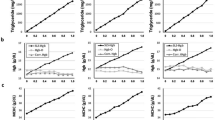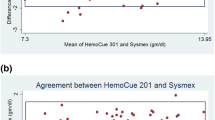Abstract
Purpose of study
To find out the prevalence of anemia in potential blood donors and to compare the direct cynmethemoglobin and HemoCue methods for assessing hemoglobin concentration.
Material and methods
The study group included 540 potential blood donors; who were tested for their hemoglobin concentration in capillary blood samples by direct cynmethemoglobin and HemoCue methods.
Results
Average age of the potential donors was 39.2 year, with 505 males and 35 females. Mean hemoglobin concentration using the HemoCue was 13.2 ± 2.4 g/dl and 12.8 ± 2.3 g/dl with the direct cynmethemoglobin method (Table 1). The prevalence of anemia was slightly higher when using the direct cynmethemoglobin method (14.1%) as compared to HemoCue method (13.6%). The sensitivity and specificity for the HemoCue assessment was 94.1% and 95.2% respectively as compared to 90.1% and 94.2% respectively for the direct cynmethemoglobin method.
Conclusion
Photometric hemoglobin determination (HemoCue) combines the convenience of onsite testing with sufficient accuracy and rapidity. We feel this is a better method for evaluating potential blood donors.
Similar content being viewed by others
References
Dallmen PR (1990) Iron — Present Knowledge in Nutrition. In: Brown M Edn. Washington DC, Nutrition Foundation, 241–250
Second Report on the World Nutrition Situation: Global and Regional Results, Geneva, United Nations. ACC Sub-Committee on Nutrition 1992 1:92–93
National Family Health Survey II (NFHS-II) Delhi: Anemia Among Women and Children, Mumbai International Institute for Population Sciences 2002, 141–157
Stoltzfus RJ (1997) Rethinking Anemia Surveillance. Lancet 349:1764–1766
Yip R (1994) Iron Deficiency — Contemporary scientific issues and international programmatic issues. Journal of Nutrition 124:1479–1490
Anaemia detection in health services: guidelines for program managers. Seattle, WA, Program for appropriate technology in Health 1996; 2:23–28
Hainline A Jr (1958) Hemoglobin. In: Seligson D edn. Standard Methods of Clinical Chemistry, New York, Academic Press, 45–51
Von Schenck H, Falkensson M, Lundberg B (1986) Evaluation of “HemoCue” — A New Device for Determining Hemoglobin. Clinical Chemistry 32:526–529
Van Assendelft OW (1971) Photometry and the standardized method for the determination of hemoglobin. Schweiz Med Wochenschr 101:1649–1652
Healy T (1994) Hemoglobin Analysis — Diagnostics in Africa. Clin Chemistry 27:2–4
Author information
Authors and Affiliations
Corresponding author
Rights and permissions
About this article
Cite this article
Akhtar, K., Sherwani, R.K., Rahman, K. et al. HemoCue photometer: a better alternative of hemoglobin estimation in blood donors?. Indian J Hematol Blood Transfus 24, 170–172 (2008). https://doi.org/10.1007/s12288-008-0041-8
Received:
Accepted:
Published:
Issue Date:
DOI: https://doi.org/10.1007/s12288-008-0041-8




